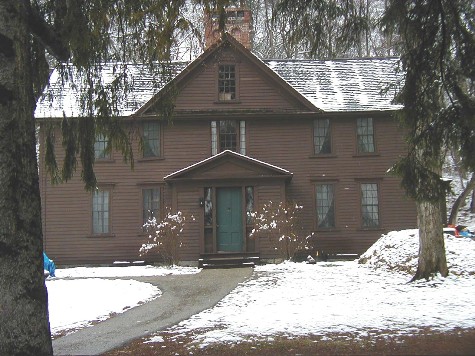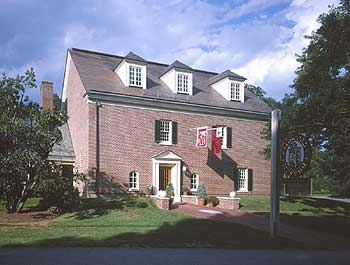Culture Vulture: Tracking the Transcendentalists
There are dozens of excellent books about the Alcotts, Emersons, Thoreau, and Hawthorne but reading them can’t beat actually walking through the places where the people actually lived.

Orchard House: Where Louisa May Alcott wrote Little Women
“We are all going to be made perfect,” wrote ten-year-old Louisa May Alcott in June of 1843, “This day we left Concord in the rain to travel by wagon the ten miles to our new home which Father has named Fruitlands.” Louisa’s father Bronson Alcott, the notoriously impractical luftmensch, set out in the spring of 1843 with his wife Abigail, his four young daughters, and his friend Charles Lane to live a utopian dream in a farmhouse off the road between Boston and Worcester, funded by his brother-in-law.
Since the Transcendentalist was against the consumption or use of animals (including cows, ducks, and chickens and their eggs) and determined to live off “the fruits of the earth” (ergo Fruitlands Farm), the family would eat only grains, fruits, and vegetables. They would draw water for drinking, cooking, and their cold baths (another of Alcott’s dicta) from the well 50 yards from the house and cut firewood in the forest. There would be no household help.
Alcott took the best room for his study and allocated the bedrooms to himself and his wife Abigail; Charles Lane; and his good friend Henry David Thoreau, whose regular visits he anticipated. Louisa and her three sisters—then 11, 8, and 3—slept in a low, narrow, third-floor attic that made Cinderella’s lodgings look luxurious.
Alcott and Charles Lane sometimes traveled together for weeks at a time during which Lane would argue for Alcott to abandon his family and form a true “consociate” community similar to the nearby Shakers.
In January of 1844, all but starving and freezing to death in the Massachusetts winter, Abigail Alcott— who had the empathy and patience of the social worker she was—finally called an end to the experiment, packed up her four young daughters, abandoned camp, and found refuge with relatives.
There are dozens of excellent books about the Alcotts, Emersons, Thoreau, and Hawthorne, but reading them can’t beat actually walking through the places where the people actually lived. It’s also nice to be able to travel by car rather than by wagon.
Driving west from Concord to Fruitlands on Route 2 on a fine spring day, you can get a sense of the lay of the land as well as the climate. It was chilly in the May sun, and we had a hot lunch at Alcott’s Restaurant and Tea Room (whose excellent menu the philosopher would surely condemn). There are also three other museums at Fruitlands, including an excellently curated small gem of a Shaker Museum.
But the main reason I went to Fruitlands was to follow the footsteps of Louisa and, in fact, I came to understand the author of Little Women in a new way. It has been pointed out by many critics that Louisa May Alcott all but wrote her admired but hapless father out of her autobiographical novel. Mr. March makes a brief appearance in Chapter 22.
Moreover, Louisa’s alter ego (and model for so many later women writers) Jo March does not marry in Little Women. She finally submits to the marriage plot via Professor Baer as a result of popular demand after readers devoured Little Men. She obliged with Jo’s Boys.
Louisa May herself never married and, like the Belle of Amherst, Louisa has become an iconic figure. Orchard House, where she wrote Little Women has become a kind of shrine visited by readers from all over the world who have read the book, often translated as “The Four Daughters of Dr. March.”
Unlike Emily Dickinson’s home in Amherst, however, Alcott’s is one of a cluster, including the historic home of Ralph Waldo Emerson, the home of his grandparents, and Walden Pond. Concord was a literary hotbed with neighbors and frequent visitors such as Ralph Waldo Emerson, Henry David Thoreau, Nathaniel Hawthorne, and Margaret Fuller, journalist, social reformer, and the first woman granted research privileges at Harvard. They were all enthusiastic walkers (their walking sticks are intriguing artifacts) who frequently visited each others’ homes.
Orchard House and Emerson’s House are less than half a mile apart; Emerson walked about one mile to the Old Manse, slightly more to Walden Pond, and 20 miles to Boston when he felt like it. Although I didn’t replicate that walk, I spent the better part of two days touring the historic Concord houses. Walden Pond and the Concord Museum are accessible year-round but, for the most part, the historic homes are open only from April to November.
All have volunteer docents who are well-versed in local history, and shops with well-stocked book sections. There is no wandering about at will except at the Concord Museum. Guided tours are the rule and, if you’re lucky, they become mini-seminars.

The Concord Museum: The place to begin tracking the Transcendentalists.
The Concord Museum is perhaps the best starting point. It’s a small, modern, but comfortingly low-tech museum (an old-fashioned diorama of the Revolutionary War reminded me of childhood days at New York’s Museum of Natural History) that starts with a display about the Algonquins who were displaced by the Colonists and provides a visual narrative to the 19th century.
The Museum boasts a nationally-significant decorative arts collection: Concord-made furniture, silver, and clocks, as well as several important historical relics. One is the lantern immortalized by Longfellow in Paul Revere’s Ride (“One if by land; two if by sea”); another is the desk where Thoreau wrote Walden and “Civil Disobedience.”
The most compelling exhibit for me is Emerson’s study, brought over in its entirety from Emerson House after a fire broke out in its original location. He wrote in a wooden rocking chair, placed next to a round table in the center of the room whose top revolved like a lazy Susan when he wished to look at something besides what he was working on.
There’s a painting by May Alcott (Amy in Little Women) hanging over the sofa as well as art Emerson brought back with him from Europe. Like Louisa, May was encouraged to visit with Emerson and peruse his treasures. The study, like all the Museum’s displays, is beautiful, but if you want to experience the actual space in which the writers lived and wrote, you will wish to hurry on.
The Old Manse, half a mile from Concord Center just outside Minuteman National Park, was the home of Emerson’s grandfather, Unitarian minister William Emerson, who began living there in 1770. The house had a clear view of the Concord River and the Revolutionary War’s North Bridge. He allegedly watched the fighting from the bedroom window and called it “The Battle in my Backyard.”
Emerson spent many summers with his grandparents and, in 1835, moved in for a short time. After Emerson moved to his own home in Concord, Nathaniel Hawthorne moved in and wrote Mosses from an Old Manse in the house. Thoreau planted a vegetable garden outside as a wedding gift.
Touring the house (a property of Massachusetts’s Trustees of Reservations) is an experience of both literary and social history. There is the minister’s parlor on the right with its fireplace and 1864 Steinway piano—an important nineteenth-century item that replaced the earlier Aeolian harp (hung in trees like contemporary wind chimes) as the musical instrument of choice for a proper family.
On the left is the study with a handsome grandfather clock from 1770 and oil paintings by yet another of the gifted women of the group, Sophia Hawthorne. She also etched a couple of the messages into the thick glass window panes, some of them 300 years old. You can try to channel both Emerson and Hawthorne in the study where the first wrote “Nature” and the second struggled with writer’s block, working on Mosses from an Old Manse while facing the wall and away from the windows. One of the most interesting rooms is the fully-furnished kitchen with its set kettle, where water was boiled; it’s an open hearth where pots were hung and a sloped sink.

Ralph Waldo Emerson House in Concord, MA
The Emerson Memorial House feels quite different from both the Concord Museum and the Old Manse. It’s still privately owned by family descendants and feels homey. Almost all the furnishings are the originals except for the study, whose originals are preserved in the fire-proof and climate-controlled building across the road.
Nonetheless, even the replicated study is a place to soak in the literary atmosphere. You can imagine Emerson in his rocking chair working at his lectures (he came to believe that a speaking career was better both financially and for disseminating his ideas than publishing), surrounded by portraits and busts of and books by the men he admired: Dante, Goethe, Thomas Carlyle, Abraham Lincoln, Charles Sumner, John Muir.
Touring the house with its fireplace in every room and places for candelabra and leather buckets for putting out fires, one becomes sensitized to the amount of time and energy expended (not by Emerson) to keep the place well-lit, well-heated, and supplied with water (there was no indoor plumbing until the 1870s).
Which provides an interesting segue to Orchard House. One of Bronson Alcott’s most pragmatic ideas, so far as I can tell, was to extend the original house, build his family’s kitchen directly over their well, and to devise a pump to deliver the water to a soapstone sink. This was ingenious, time-saving, possibly life-saving arrangement in the bitter winters and probably much appreciated by his wife and daughters after their Spartan conditions on Fruitlands Farm.
Orchard House was also close to Concord Center and on the site of a real apple orchard—12 acres of orchard as per Thoreau, who survey the land for them. The Alcotts moved into the house in 1858 and lived there for 20 years.
Father Alcott believed in progressive, child-centered education. Two more ingenious ideas, for which he is justly honored, were to encourage all his daughters to write in daily journals and to allow May to sketch on the walls of her room.
All four of his daughters experimented with music and theater as well as the visual arts: the two older girls even founded a quasi-community theater called The Concord Dramatic Players Union. May’s impressive artistic work hangs on the walls.
But, for me, the most moving artifact in Orchard House is Louisa’s desk, a tiny half-moon of wood that her father built into the wall, where she sat and sometimes wrote for 14 hours at a stretch.
By the time she died at age 55 in 1888, she had written more than 30 books that have been translated into 50 languages, had toured Europe like her hero Emerson, raised her late sister May’s daughter Lulu, and was finally able to maintain a comfortable lifestyle with an apartment in Boston’s Louisburg Square.
You can read about Louisa May Alcott, her father, Thoreau, Emerson, Hawthorne, and their world in several notable books like John Matteson’s Eden’s Outcasts; Megan Marshall’s The Peabody Sisters; and Robert D. Richardson’s Emerson: The Mind on Fire. But now’s the time to visit where they lived and worked.
Helen Epstein‘s work is now available on Kindle, including her essay on Memoir.
The new edition of Helen Epstein’s Music Talks is available online and at music outlets like the shop at Symphony Hall in Boston. She is also the author of Joe Papp and “Where She Came From.” Order these books through the link to Amazon on The Arts Fuse and magazine receives a (small) percentage of the sale.
Tagged: Bronson Alcott, Culture Vulture, Emerson Memorial House, Emerson's House, Fruitlands, Henry David Thoreau, Louisa May Alcott, Museums, Nathaniel Hawthorne, New England, Orchard House, Ralph Waldo Emerson, The Concord Museum, The Old Manse, Transcendentalists

